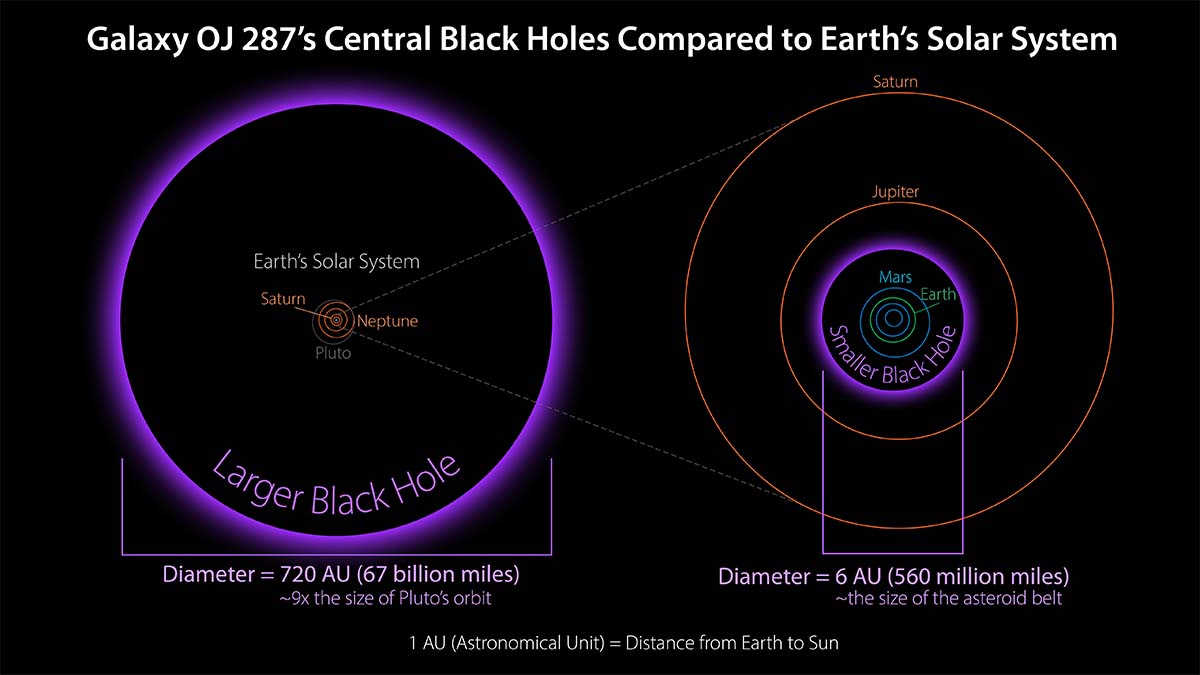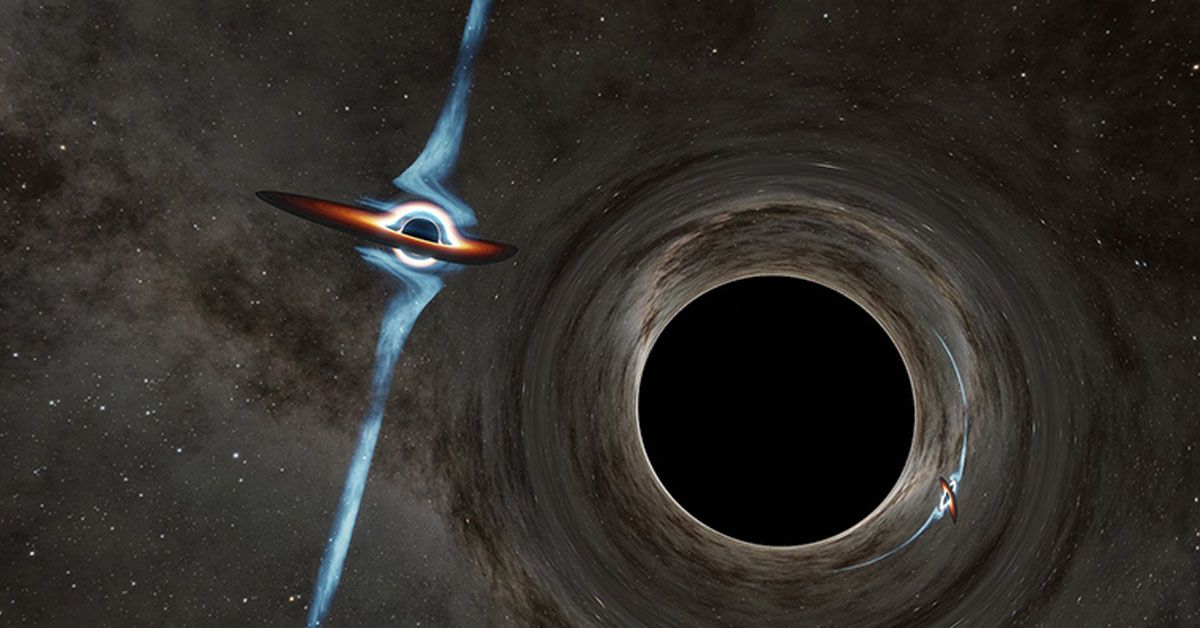In the boundless universe, supermassive black holes stand as extraordinary cosmic phenomena, eliciting both intrigue and admiration. These aren't simply massive, they're supermassive, with a weight that dwarfs our Sun billions of times over!
Can you imagine the cosmic spectacle when not one, but two of these gigantic entities engage in an interstellar ballet?
Far from being a page torn from a sci-fi story, this scenario is the compelling truth for the galaxy known as OJ287, which boasts a binary system of supermassive black holes. The keen-eyed astronomers at the University of Turku first unearthed this extraordinary duo, and their discovery has opened new doors to the secrets of the cosmos.
Discovery of the Binary Black Hole System, OJ287
Our journey to understand OJ287 starts way back in history. Indeed, astronomers have been keenly observing this enigmatic celestial object since 1888. Over the course of more than a century, they noticed something rather unusual.
This wasn't your everyday galaxy. The radiation emissions from OJ287 displayed a remarkable pattern, following not just one, but two distinct cycles. A mystery was starting to unfold like a cosmic detective story set billions of light-years away.
At the heart of the mystery was the binary black hole system in OJ287. Picture two supermassive black holes, one in orbit around the other, like cosmic dance partners.

The primary black hole plays the leading role, weighing in at an astonishing 18 billion times the mass of our Sun! Its partner, the secondary black hole, might seem diminutive in comparison but still tips the cosmic scales at 150 million solar masses.
Yet, their extraordinary dance wasn't happening in empty space. Surrounding the primary black hole was a fascinating structure known as a gas disk. Picture a colossal spinning record made of dust and gas, with the primary black hole in the center like the spindle.
This gas disk, churning with intense cosmic forces, played a crucial role in the spectacle that led to the secondary black hole's detection.
Unusual Behavior of the OJ287 Binary System: The Blue Flash
What sets the OJ287 binary system apart is not just its existence, but also the peculiar behavior exhibited by its celestial constituents. Picture the secondary black hole, a whopping 150 million solar masses, engaged in an orbit around its bigger counterpart that spans 12 years.
But this isn't your ordinary, circular orbit. Instead, it's a dynamic, teardrop-shaped trajectory, sending the secondary black hole swooping through the primary's gas disk not once, but twice during each orbit.
The unique orbit of the secondary black hole has led to some stunning observations. As it dives through the gas disk, it disrupts the swirling matter, causing ripples of effects that propagate across the disk.

The most dramatic manifestation of these disruptions was a spectacular event that grabbed the attention of astronomers worldwide: a brilliant blue flash lighting up the galaxy, detected back in February 2022.
This flash was more than just a stunning cosmic firework. It was also a telltale sign of the secondary black hole's presence. In fact, the flash was so bright that the secondary black hole couldn't hide its existence any longer.
Along with the blue flash, the secondary black hole sent out vibrant bursts of radiation, weeks before the main event. Like cosmic breadcrumbs, these bursts were the direct signals from the secondary black hole, revealing its path through the disk and its fascinating interaction with the primary black hole.
Research and Studies on the OJ287 Binary System
At the forefront of the fascinating journey of understanding the OJ287 binary system is the University of Turku. Over the years, their dedicated astronomers have tirelessly gathered data, made observations, and carried out in-depth studies.
An array of observational campaigns were meticulously planned and executed to validate these groundbreaking findings. And their efforts bore fruit: the existence of the supermassive black hole pair in OJ287 was confirmed. Not only that but for the first time ever, the smaller black hole was directly observed.
The clues leading to this remarkable discovery were hidden in the range of signals and flares emanating from the binary system. These signals weren't mere cosmic noise but were like the rhythm to which the black holes danced.
But the surprises didn't stop there. Scientists observed a spectacular flare that outshone all previous records during one of these observation periods.
This wasn't one of the expected, fortnight-long flares that usually marked the secondary black hole's transit through the gas disk. Instead, it was an unexpected, dazzling burst that lasted a mere day, yet brightened OJ287 dramatically.
Alongside these exciting observations, another fascinating phenomenon was detected by NASA's Fermi telescope. It captured a gamma-ray flare, the high-energy flash resulting from the interaction between the smaller black hole's jet and the gas in the disk.
This wasn't the first time such a flare had been observed. Back in 2013, a similar gamma-ray event had been recorded. However, connecting these flares to the interaction between the secondary black hole and the gas disk added a new layer to our understanding of OJ287.
The Research Potential of OJ287
Peering into the cosmic spectacle of OJ287 opens up a world of possibilities. In fact, this extraordinary binary system is seen as a golden opportunity to study gravitational waves.
The synchronized dance of the supermassive black holes in OJ287 makes it the prime candidate for producing detectable gravitational waves. Imagine the significance of such an observation, allowing us to perceive the universe in an entirely new way!

Keeping a vigilant eye on OJ287 are two significant global consortia: the Event Horizon Telescope and the Global mm-VLBI Array. Their routine monitoring activities form the backbone of our ongoing exploration of this dynamic system.
Armed with high-tech telescopes and cutting-edge technology, they tirelessly gather data, capturing every flicker and flash emitted by the celestial dance in OJ287.
Sources: academic.oup.com / purdue.edu












